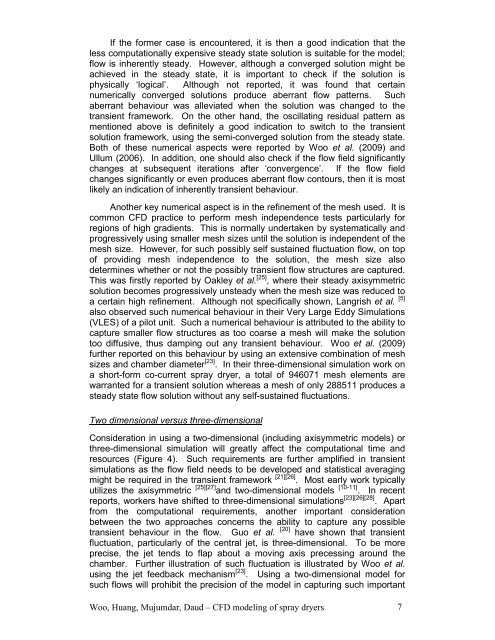Spray Drying Technology.pdf - National University of Singapore
Spray Drying Technology.pdf - National University of Singapore
Spray Drying Technology.pdf - National University of Singapore
Create successful ePaper yourself
Turn your PDF publications into a flip-book with our unique Google optimized e-Paper software.
If the former case is encountered, it is then a good indication that the<br />
less computationally expensive steady state solution is suitable for the model;<br />
flow is inherently steady. However, although a converged solution might be<br />
achieved in the steady state, it is important to check if the solution is<br />
physically ‘logical’. Although not reported, it was found that certain<br />
numerically converged solutions produce aberrant flow patterns. Such<br />
aberrant behaviour was alleviated when the solution was changed to the<br />
transient framework. On the other hand, the oscillating residual pattern as<br />
mentioned above is definitely a good indication to switch to the transient<br />
solution framework, using the semi-converged solution from the steady state.<br />
Both <strong>of</strong> these numerical aspects were reported by Woo et al. (2009) and<br />
Ullum (2006). In addition, one should also check if the flow field significantly<br />
changes at subsequent iterations after ‘convergence’. If the flow field<br />
changes significantly or even produces aberrant flow contours, then it is most<br />
likely an indication <strong>of</strong> inherently transient behaviour.<br />
Another key numerical aspect is in the refinement <strong>of</strong> the mesh used. It is<br />
common CFD practice to perform mesh independence tests particularly for<br />
regions <strong>of</strong> high gradients. This is normally undertaken by systematically and<br />
progressively using smaller mesh sizes until the solution is independent <strong>of</strong> the<br />
mesh size. However, for such possibly self sustained fluctuation flow, on top<br />
<strong>of</strong> providing mesh independence to the solution, the mesh size also<br />
determines whether or not the possibly transient flow structures are captured.<br />
This was firstly reported by Oakley et al. [25] , where their steady axisymmetric<br />
solution becomes progressively unsteady when the mesh size was reduced to<br />
a certain high refinement. Although not specifically shown, Langrish et al. [5]<br />
also observed such numerical behaviour in their Very Large Eddy Simulations<br />
(VLES) <strong>of</strong> a pilot unit. Such a numerical behaviour is attributed to the ability to<br />
capture smaller flow structures as too coarse a mesh will make the solution<br />
too diffusive, thus damping out any transient behaviour. Woo et al. (2009)<br />
further reported on this behaviour by using an extensive combination <strong>of</strong> mesh<br />
sizes and chamber diameter [23] . In their three-dimensional simulation work on<br />
a short-form co-current spray dryer, a total <strong>of</strong> 946071 mesh elements are<br />
warranted for a transient solution whereas a mesh <strong>of</strong> only 288511 produces a<br />
steady state flow solution without any self-sustained fluctuations.<br />
Two dimensional versus three-dimensional<br />
Consideration in using a two-dimensional (including axisymmetric models) or<br />
three-dimensional simulation will greatly affect the computational time and<br />
resources (Figure 4). Such requirements are further amplified in transient<br />
simulations as the flow field needs to be developed and statistical averaging<br />
might be required in the transient framework [21][26] . Most early work typically<br />
utilizes the axisymmetric [25][27] and two-dimensional models [10-11] . In recent<br />
reports, workers have shifted to three-dimensional simulations [23][26][28] . Apart<br />
from the computational requirements, another important consideration<br />
between the two approaches concerns the ability to capture any possible<br />
transient behaviour in the flow. Guo et al. [20] have shown that transient<br />
fluctuation, particularly <strong>of</strong> the central jet, is three-dimensional. To be more<br />
precise, the jet tends to flap about a moving axis precessing around the<br />
chamber. Further illustration <strong>of</strong> such fluctuation is illustrated by Woo et al.<br />
using the jet feedback mechanism [23] . Using a two-dimensional model for<br />
such flows will prohibit the precision <strong>of</strong> the model in capturing such important<br />
Woo, Huang, Mujumdar, Daud – CFD modeling <strong>of</strong> spray dryers 7

















